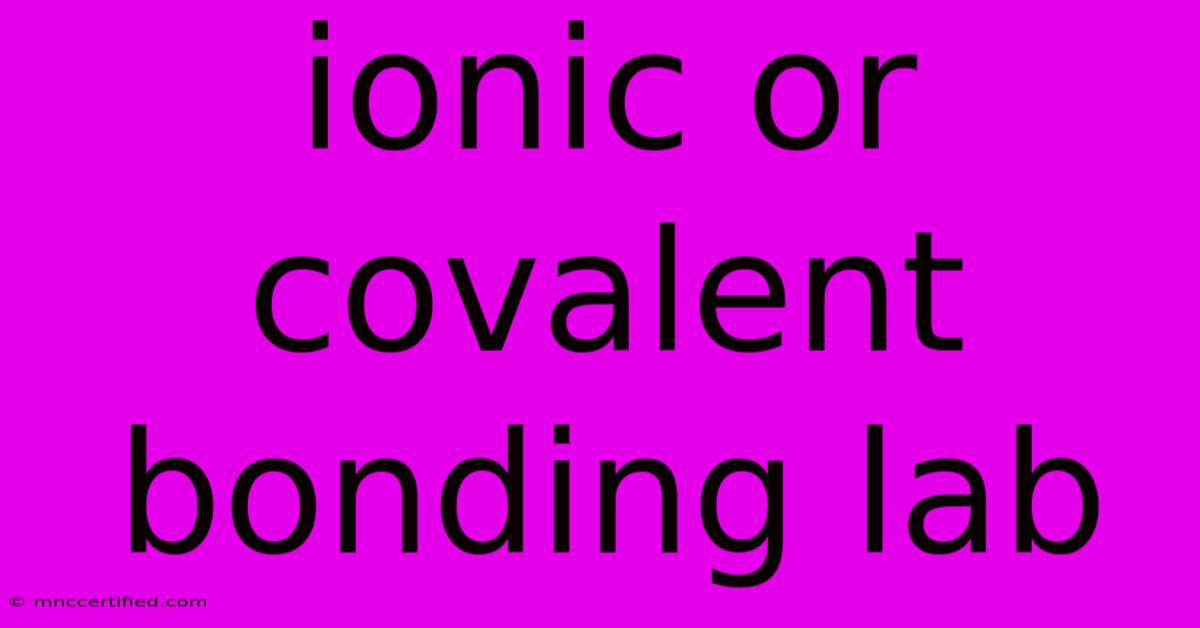Ionic Or Covalent Bonding Lab

Table of Contents
Ionic or Covalent Bonding Lab: A Comprehensive Guide
This guide provides a detailed walkthrough of a lab designed to differentiate between ionic and covalent bonding. We'll cover experimental procedures, safety precautions, data analysis, and potential extensions to deepen your understanding of chemical bonding. This lab is suitable for high school and introductory college chemistry courses.
Understanding Ionic and Covalent Bonds
Before diving into the lab, let's review the fundamental differences between ionic and covalent bonds.
-
Ionic Bonds: Formed through the electrostatic attraction between oppositely charged ions. This occurs when one atom (typically a metal) donates an electron(s) to another atom (typically a nonmetal), creating a cation (positive ion) and an anion (negative ion). Ionic compounds generally have high melting points and boiling points, are often crystalline solids, and conduct electricity when dissolved in water or molten.
-
Covalent Bonds: Formed by the sharing of electrons between two nonmetal atoms. Covalent compounds generally have lower melting and boiling points than ionic compounds and often exist as liquids or gases at room temperature. They typically do not conduct electricity when dissolved or molten.
Materials and Equipment
This experiment requires common lab materials. Ensure you have:
- Safety Goggles: Essential for eye protection.
- Lab Coat: Protect your clothing from spills.
- Various Compounds: Include at least one ionic compound (e.g., sodium chloride, NaCl) and one covalent compound (e.g., sucrose, C₁₂H₂₂O₁₁). Consider including additional compounds for broader data analysis.
- Distilled Water: Use pure water to avoid interference from dissolved ions.
- Conductivity Tester: Used to determine the electrical conductivity of solutions.
- Beakers: For dissolving compounds.
- Stirring Rods: To mix solutions.
- Bunsen Burner (Optional): To observe melting points (requires caution and adult supervision).
- Melting Point Apparatus (Optional): Provides a more precise measurement of melting points.
Experimental Procedure
Safety First: Always wear safety goggles and a lab coat. Handle chemicals with care and follow your instructor's guidance.
-
Preparation: Label beakers clearly to avoid confusion. Prepare solutions of your chosen ionic and covalent compounds in distilled water. Use equal molar concentrations for a fair comparison.
-
Conductivity Test: Carefully insert the conductivity tester into each solution. Record whether the solution conducts electricity (lights up) or not.
-
Melting Point Determination (Optional): If using a Bunsen burner, carefully heat small samples of each solid compound. Observe and record the melting points. Exercise extreme caution when using a Bunsen burner. A melting point apparatus provides a safer and more accurate method.
-
Solubility Test (Optional): Observe the solubility of each compound in water. Note any observations about the rate and extent of dissolving.
Data Analysis and Interpretation
Create a table to organize your results. Include columns for the compound name, type of bond (predicted), conductivity (yes/no), melting point (if measured), and solubility observations.
Analyze your results: Do your findings support your predictions about ionic and covalent bonding? Explain any discrepancies. Discuss the limitations of the experiment and potential sources of error.
Conclusion
Summarize your findings and discuss how the experiment helped differentiate between ionic and covalent bonding. Relate your observations to the characteristics of each bond type.
Extending the Lab
To enhance the learning experience, consider these extensions:
- Investigate more compounds: Expand the range of ionic and covalent compounds tested.
- Explore other properties: Investigate other physical properties like hardness, brittleness, or crystal structure.
- Model building: Use molecular model kits to visualize the structures of ionic and covalent compounds.
- Research applications: Research real-world applications of ionic and covalent compounds.
This comprehensive guide provides a robust foundation for conducting a successful ionic or covalent bonding lab. Remember to always prioritize safety and thoroughly analyze your data for a meaningful learning experience. By following these steps and incorporating the suggested extensions, you can gain a deeper understanding of this crucial aspect of chemistry.

Thank you for visiting our website wich cover about Ionic Or Covalent Bonding Lab. We hope the information provided has been useful to you. Feel free to contact us if you have any questions or need further assistance. See you next time and dont miss to bookmark.
Featured Posts
-
Kind Of Bond In Chemistry Nyt
Nov 28, 2024
-
Fbi On D B Coopers Identity
Nov 28, 2024
-
Sa Vs Sl 1st Test Highlights Day 1 Stumps
Nov 28, 2024
-
Luton Vauxhall Factory Stellantis Closure
Nov 28, 2024
-
Lana Del Rey Uk Ireland Tour Ticket Prices
Nov 28, 2024